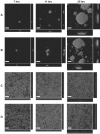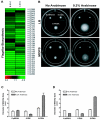Transcriptome and phenotypic responses of Vibrio cholerae to increased cyclic di-GMP level
- PMID: 16672614
- PMCID: PMC1482859
- DOI: 10.1128/JB.188.10.3600-3613.2006
Transcriptome and phenotypic responses of Vibrio cholerae to increased cyclic di-GMP level
Abstract
Vibrio cholerae, the causative agent of cholera, is a facultative human pathogen with intestinal and aquatic life cycles. The capacity of V. cholerae to recognize and respond to fluctuating parameters in its environment is critical to its survival. In many microorganisms, the second messenger, 3',5'-cyclic diguanylic acid (c-di-GMP), is believed to be important for integrating environmental stimuli that affect cell physiology. Sequence analysis of the V. cholerae genome has revealed an abundance of genes encoding proteins with either GGDEF domains, EAL domains, or both, which are predicted to modulate cellular c-di-GMP concentrations. To elucidate the cellular processes controlled by c-di-GMP, whole-genome transcriptome responses of the El Tor and classical V. cholerae biotypes to increased c-di-GMP concentrations were determined. The results suggest that V. cholerae responds to an elevated level of c-di-GMP by increasing the transcription of the vps, eps, and msh genes and decreasing that of flagellar genes. The functions of other c-di-GMP-regulated genes in V. cholerae are yet to be identified.
Figures







References
-
- Ali, A., J. A. Johnson, A. A. Franco, D. J. Metzger, T. D. Connell, J. G. Morris, Jr., and S. Sozhamannan. 2000. Mutations in the extracellular protein secretion pathway genes (eps) interfere with rugose polysaccharide production in and motility of Vibrio cholerae. Infect. Immun. 68:1967-1974. - PMC - PubMed
-
- Bao, Y., D. P. Lies, H. Fu, and G. P. Roberts. 1991. An improved Tn7-based system for the single-copy insertion of cloned genes into chromosomes of gram-negative bacteria. Gene 109:167-168. - PubMed
-
- Bobrov, A. G., O. Kirillina, and R. D. Perry. 2005. The phosphodiesterase activity of the HmsP EAL domain is required for negative regulation of biofilm formation in Yersinia pestis. FEMS Microbiol. Lett. 247:123-130. - PubMed
Publication types
MeSH terms
Substances
Grants and funding
LinkOut - more resources
Full Text Sources
Molecular Biology Databases

